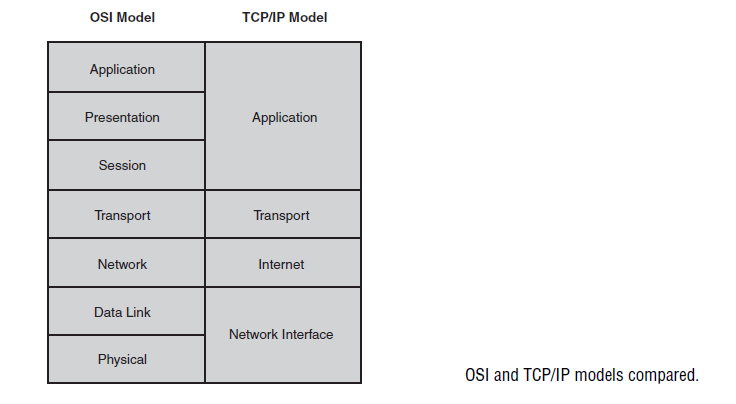
Layer 2: The Data Link Layer
The data link layer is responsible for taking the Layer 3 packet (regardless of
which protocol created it—IP, IPX, and so on) and preparing a frame for the

packet to be transmitted on the media. There are, of course, many different
Layer 2 frame types; in CCNA, we are interested in only the following:
.
Ethernet.
Frame Relay.
Point-to-Point Protocol (PPP).
High-Level Data Link Control protocol (HDLC).
Cisco Discovery Protocol (CDP)
The type of frame created depends on the type of network service in use; if it is
an Ethernet interface, obviously it will be creating Ethernet frames. A router
serial port can create several different frame types, including PPP, HDLC, and
Frame Relay.
The data link layer uses flat addressing—not hierarchical as in Layer 3. In
Ethernet, the addresses in question are MAC addresses. MAC stands for Media
Network Models
Access Control. A MAC address is a number assigned by the manufacturer of a
NIC, burned in at the factory. For this reason, it is sometimes called a hardware
or physical address, again as opposed to the logical addressing at Layer 3. A valid
MAC address will consist of 12 hexadecimal characters. The first six characters
are called the
OUI (Organizationally Unique Identifier), and identify the companythat made the card. The last six characters are the card serial number. Following
are some valid MAC addresses as examples:
00-0F-1F-AE-EE-F0
00-00-0C-01-AA-CD
A MAC address must be unique within a broadcast domain. This is because one
of the functions of Ethernet is that a host will broadcast an ARP request to find
out the MAC address of a particular IP; if there are two identical MACs in that
broadcast domain, there will be serious confusion.
In other Layer 2 network types, the addresses are not MACs but serve an equivalent
purpose. Frame Relay, for example uses DLCIs (Data Link Connection
Identifiers). A dial-up link using regular analog phone or digital ISDN will use
the phone number as the Layer 2 address of the IP you are trying to reach.
Remember that you must always resolve an IP address down to some type of
Layer 2 address, and there will always be a mechanism to do so.
C addresses
in frames and forward them to the appropriate link. (We’ll go into more detail
on switching technology in Chapter 6, “Basic Catalyst Switch Operations and
Configuration.”)